The New MacBook Pros: Provisionally The Best Mac Notebooks Ever
Wednesday, April 14, 2010
by Charles W. Moore
After 10 months and in the wake of all the iPad hype and hoopla, we finally have some new serious tool Macs in the form of Apple’s new MacBook Pros. The third-generation refreshment proved to be just about what I expected, save for the fact that the 13 inch model retains a Core 2 Duo processor rather than one of Intel’s latest 32 nanometer technology Core i3 or i5 CPUs. More discussion about that below.
Apple wisely chose not to mess with the delightful and extremely solid aluminum unibody design, minimal change of which suits me fine, since the aluminum unibody is my favorite Apple portable since the PowerBook G3 Pismo of 10 years ago, particularly that 13 inch model, which, notwithstanding a bit of disappointment with regard to Apple’s processor choice (which may not be so bad) remains my default recommendation for a general-purpose laptop for most users.
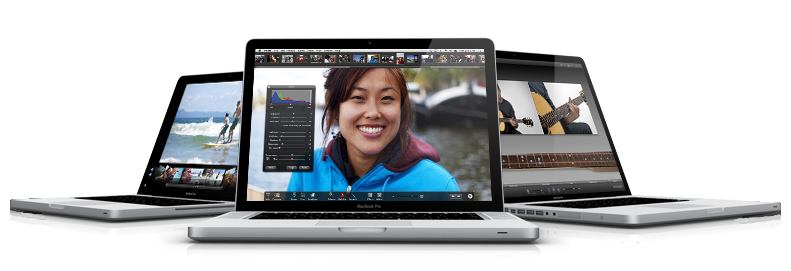
Photo Courtesy Apple
It also appears that speculation as to why Apple was so slow out of the blocks in getting Core “i” machines into the channels being due to the ongoing third-party dispute between Intel and NVIDIA over licensing the latter to create integrated graphics processing silicon for the new Intel CPU family. Some sort of accommodation has now obviously been agreed to, since the 15 inch and 17 inch MBPs are equipped with the new NVIDIA GeForce 330M 48 core graphics processor unit (as opposed to the 32 core GeForce 9600M GT GPU used in 17” and high-end 15” 2nd gen. MBPs) that Apple claims can provide performance up to twice as fast as the integrated GeForce 320M graphics in the new 13-inch MacBook Pros, but the two larger models Core “i” models use more pedestrian Intel HD integrated graphics rather than the GeForce 320M.
Price points have pretty much held close to where they were with the previous generation. The entry-level 15-inch MacBook Pro has been bumped by $100 to $1,799, but value is obviously there in that the base 15-incher now has two graphics processors featuring “automatic graphics switching technology” that toggles back and forth seamlessly between the Intel integrated graphics and the much more powerful Nvidia discrete GPU based on intensity of demand, just like its more expensive siblings, whereas the corresponding $1,699 second-generation model had an almost identical internal specification to the higher-end 2.53 GHz 13 inch MacBook Pro with only an NVIDIA GeForce integrated graphics chipset available.
Since the base 15 inch MacBook Pro now also comes with a 2.4 GHz Intel Core i5 as opposed to the third-generation $1,499 13 inch model’s 2.66 GHz Intel Core 2 Duo CPU, there’s obviously a much wider specification and performance gap between these two models than there had been previously, making it hard to straight-facedly complain about the or 6 percent price bump.
Prices have actually been lowsered slightly on the high-end 15 inch unit from $2,299 to $2,199 (4 percent), and on the 17-in. MacBook Pro from $2,499 to $2,299 a substantial 8 percent drop.
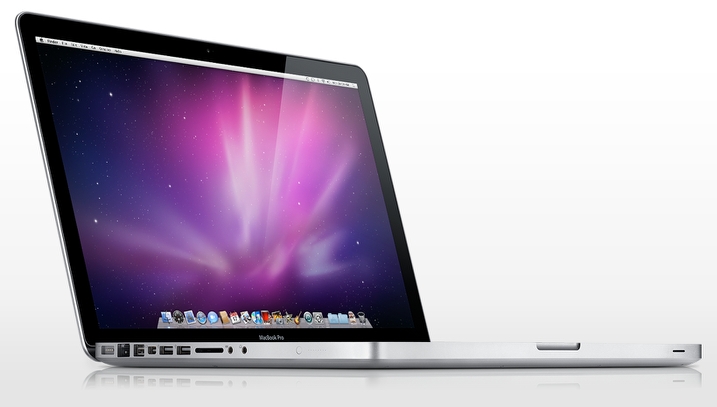
Photo Courtesy Apple
One interesting note about “automatic graphics switching, is that while you can turn it off using a checkbox in the Energy Saver System Preference panel, graphics support will default to discrete graphics-only mode, with no user option to alternatively specify staying in the integrated graphics system.
So what else is new? Battery runtime is claimed to now be 8 to 9 hours depending on how often the system dips into discrete graphics mode (10 hours for the 13” model), enhanced from 7 to 8 hours for the June 2009 revision machines, and the 13-inchers also get 4GB RAM as standard equipment. With the 15” model you now also have the option of 1680x1050 display resolution In addition to the standard 1440x900. The 17” MacBook Pro comes standard with a 1920 x 1200 resolution display. Matte coated displays in addition to the standard glossies are available for the 15” high-res and 17” units, but still not for the 13-incher.
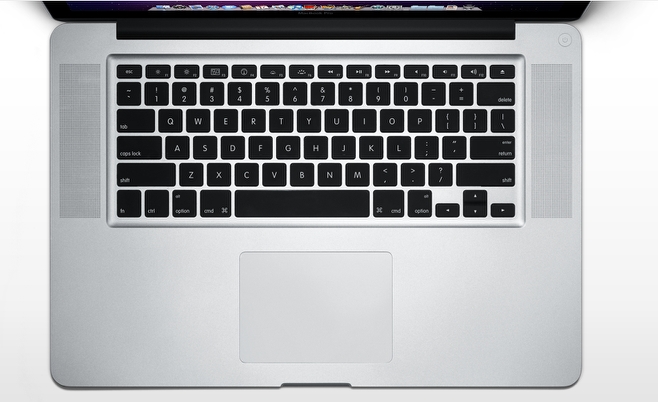
Photo Courtesy Apple
The The MacBook Pro glass Multi-Touch trackpad now supports inertial scrolling (a most welcome addition), and a 512GB Solid State Drive is also optionally available (in addition to 128GB and 256GB SSDs) on all models, albeit at a suck-in-your-breath $1300 tariff, as compared with a relatively modest $200 for the optional 500GB 7200rpm conventional hard drive.
While the maximum nominal clock speed has actually taken a rollback on the 15 inch and 17 inch models (see more on this below), real-world performance with these units is claimed to be up to 50% better than it was with the outgoing Core 2 Duo models, since the Core i5 and i7 processors integrate their memory controller and Level 3 cache for faster access to system memory.
Expansion bay configurations are something that hasn’t changed, with the 13” and 15” models offered only with a SD Card slot, and the ExpressCard/34 slot reserved for the 17 inch model. There is still no availability of built-in Blue Ray optical drive support. Evidently, Steve Jobs is still not a Blue Ray fan. I don't really miss Blu-Ray much, but a more serious omission in my estimation is that there's still no USB 3 support -- something I had been expecting with this MacBook Pro refresh. No eSATA either (third-party workaround here: http://www.sonnettech.com/product/temposataedgeexpress34.html ) Very peculiar. At least we still have FireWire on all MacBook Pro models
Incidentally, that new NVIDIA 320M integrated graphics (confusingly, NVIDIA also makes a GeForce GT 320M graphics processor) chipset that comes with the abidingly Core 2 Duo 13 inch MacBook Pro, replacing the first and second generation models’ GeForce 9400M chipset and touted as the “fastest integrated graphics processor on the market”, is reportedly a custom design at least currently unique to Apple that offers up to 80 percent faster graphics performance than the already more than respectably fast 9400M did while using as little as 40 percent as much power as the 16 core 9400M. The 48 core 320M annexes up to 256MB of the main system memory rather than having its own, dedicated VRAM.
Apple’s rationale for sticking with Core 2 Duo CPUs, but upgrading the graphics in the 13” model, was evidently to enable that theoretical 10-hour battery runtime, although one might speculate that it also might have had something to do with holding the line on the base 13-incher’s $1,099 price point, since the Core “i” chips are more expensive than the thoroughly-amortized Core 2 Duos. Whether we will eventually see Core i3 processors, which are available a dual-core processor available at 3.06GHz and 2.93GHz clock speeds, but only with Intel HD integrated graphics, in 13” MacBook Pros, is a matter for conjecture at this point, as is whether the GeForce GT 320M chipset ultimately makes its way into the $999 polycarbonate-bodied MacBook’s next revision.
However, even if it proved possible to graft the NVIDIA 320M integrated graphics chipset onto the Core i3, Apple might not want the consumer confusion of having the smaller, cheaper MBPs offered with faster clock speeds than are available with the quad-core (sort of -- as I understand it, they are actually dual-core CPUs with “Hyper-Threading” that lets two threads run simultaneously on each core, recognized by OS X four “virtual” cores) Core i5 and i7 CPUs of the larger, more expensive models, which have, as noted above, actually been scaled back from the maximum 2.8GHz that was available in the preceding high-end Core 2 Duo models, to 2.66 GHz with the Core “i”s. It’s probably enough of a marketing hiccup that there are now 2.66 GHz Core 2 Duo processors offered with the 13” machine and also 2.66 GHz Core “i” CPUs with the 15” and 17” models, although in fact the latter are much faster than the former, and the Core “i” chips’ “Turbo Boost” feature can provide shortish bursts from the nominal 2.66 GHz to 3.06 GHz for intensive dual core tasks, and up to 3.33 GHz for single core tasks -- sort of analogous to using nitrous oxide systems injection in automobiles to provide a short-duration horsepower boost (for an entertaining video demonstration of that, visit http://paultan.org/2006/02/23/how-does-nitrous-oxide-work/) or cutting in an afterburner on a jet aircraft.
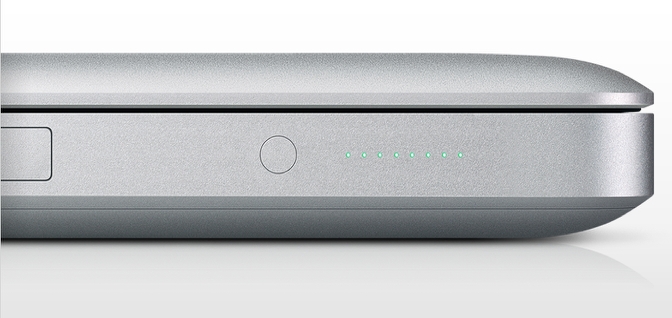
Photo Courtesy Apple
Personally, I’m still not smitten with the built-in, non-swappable batteries introduced with the MacBook Air, the 1st-gen 17” unibody MacBook Pro, and the entire 2ng-gen. MBP lineup, but Apple argues that the built-in battery design results in less waste and depleted batteries (they’re rated for approximately 1,000 charge cycles) can be replaced for $129 or $179 depending on model, which includes installation and disposal of the spent battery in an environmentally responsible manner.
However, other than the long wait, in general I’m mighty pleased with the way Apple has executed this upgrade, notwithstanding that the continued unavailability of Core “i” power in my favorite current Mac system of all (and perhaps even of all-time) -- the 13” MacBook Pro, is a bit of a disappointment as is the absence of USB 3. That said, even my 1st-gen. 2 GHz unibody MacBook with GeForce 9400M graphics is so lively that I probably would have nothing to complain about with a 2.4 GHz or 2.66 GHz Core 2 Duo and that GeForce 320M graphics chipset, and since we’re stuck with built-in batteries, a rated 10-hour runtime on a single charge makes that easier to take. My own system upgrade cycle still has nearly two years to go before I move up from my current machine, and I’m anticipating that Core “i” will be available on a 13” model by then, but in the meantime, if you’re in the market, there’s no reason to hold back. If you simply must have Core “i”, that new $1,799 15” unit is a very attractive value.
Time will tell, but these 3rd-generation unibodies could well be the best Apple notebook computers yet.
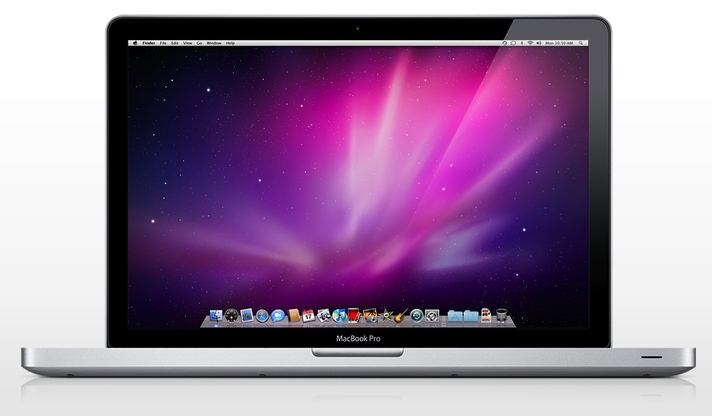
Photo Courtesy Apple
The new 13-inch MacBook Pro is offered in two configurations: the base model with a 2.4 GHz Intel Core 2 Duo and 250GB hard drive priced at $1,199.00; and a upmarket unit with a 2.66 GHz Intel Core 2 Duo and 320GB hard drive for $1,499.00. The previous 2nd-gen.models had 2.26GHz and 2.53GHz processors. The base unit is an unbeatable value here.
The new 15-inch MacBook Pro is available in three models: the base unit with a 2.4 GHz Intel Core i5, NVIDIA GeForce GT 330M and 320GB hard drive at $1,799.00; a “middle model” with a 2.53 GHz Intel Core i5, NVIDIA GeForce GT 330M and 500GB hard drive at $1,999; and a high-end configuration with a 2.66 GHz Intel Core i7 (making it the fastest standard-spec. MacBook Pro available, although the 2.66 GHz Core i7 CPU is a BTO option for the 17” model), NVIDIA GeForce GT 330M and 500GB hard drive at $2,199.00. Unless you’re a gamer, video professional, or other species of power-junkie, go for the entry-level unit, which enjoys the greatest value enhancement in this refreshment among the six models, notwithstanding the $100 price hike.
The new 17-inch MacBook Pro comes in just one model (albeit with a number of BTO options) featuring a 2.53 GHz Intel Core i5, NVIDIA GeForce GT 330M and 500GB hard drive for $2,299.
If you’re having trouble making up your mind as to which unit is best for you, check out Apple’s parallel column features comparo here:
http://www.apple.com/macbookpro/specs-compare.html
Detailed Specification For The 3rd-Generation Unibody MacBook Pros
The 2.4 GHz, 13-inch MacBook Pro, for a suggested retail price of $1,199.00, includes:
* 13.3-inch widescreen LED-backlit 1280 x 800 glossy display;
* 2.4 GHz Intel Core 2 Duo with 3MB shared L2 cache;
* 1066 MHz front-side bus;
* 4GB 1066 MHz DDR3 SDRAM, expandable to 8GB;
* NVIDIA GeForce 320M integrated graphics;
* 250GB serial ATA hard drive running at 5400 rpm, with Sudden Motion Sensor;
* a slot-load 8X SuperDrive with double-layer support (DVDÝR DL/DVDÝRW/CD-RW) optical drive;
* Mini DisplayPort (VGA, DVI and HDMI adapters sold separately);
* AirPort Extreme 802.11n wireless networking and Bluetooth 2.1+EDR;
* Gigabit Ethernet port;
* iSight video camera;
* two USB 2.0 ports;
* one FireWire 800 port (FireWire 400 compatible);
* SD card slot;
* combined headphone/line in (analog/digital);
* glass Multi-Touch trackpad and illuminated keyboard;
* built-in, 63.5WHr lithium polymer battery; and
* 60 Watt MagSafe Power Adapter.
The 2.66 GHz, 13-inch MacBook Pro, for a suggested retail price of $1,499.00, includes:
* 13.3-inch widescreen LED-backlit 1280 x 800 glossy display;
* 2.66 GHz Intel Core 2 Duo with 3MB shared L2 cache;
* 1066 MHz front-side bus;
* 4GB 1066 MHz DDR3 SDRAM, expandable to 8GB;
* NVIDIA GeForce 320M integrated graphics;
* 320GB serial ATA hard drive running at 5400 rpm, with Sudden Motion Sensor;
* a slot-load 8X SuperDrive with double-layer support (DVDÝR DL/DVDÝRW/CD-RW) optical drive;
* Mini DisplayPort (VGA, DVI and HDMI adapters sold separately);
* AirPort Extreme 802.11n wireless networking and Bluetooth 2.1+EDR;
* Gigabit Ethernet port;
* iSight video camera;
* two USB 2.0 ports;
* one FireWire 800 port (FireWire 400 compatible);
* SD card slot;
* combined headphone/line in (analog/digital);
* glass Multi-Touch trackpad and illuminated keyboard;
* built-in, 63.5WHr lithium polymer battery; and
* 60 Watt MagSafe Power Adapter.
Build-to-order options for the 13-inch MacBook Pro include the ability to upgrade to 8GB 1066 MHz DDR3 SDRAM, a 320GB 5400 rpm or a 500GB 5400 rpm hard drive, a 128GB, 256GB or 512GB solid state drive, Mini DisplayPort to DVI Adapter, Mini DisplayPort to Dual-Link DVI Adapter (for 30-inch DVI display), Mini DisplayPort to VGA Adapter, Apple Remote, Apple MagSafe Airline Adapter and the AppleCare Protection Plan.
The 2.4 GHz, 15-inch MacBook Pro, for a suggested retail price of $1,799.00, includes:
* 15.4-inch widescreen LED-backlit 1440 x 900 glossy display;
* 2.4 GHz Intel Core i5 with 3MB shared L3 cache;
* 4GB 1066 MHz DDR3 SDRAM, expandable to 8GB;
* integrated Intel HD Graphics + NVIDIA GeForce GT 330M discrete graphics with 256MB of VRAM;
* 320GB serial ATA hard drive running at 5400 rpm, with Sudden Motion Sensor;
* a slot-load 8X SuperDrive with double-layer support (DVDÝR DL/DVDÝRW/CD-RW) optical drive;
* Mini DisplayPort (VGA, DVI and HDMI adapters sold separately);
* AirPort Extreme 802.11n wireless networking and Bluetooth 2.1+EDR;
* Gigabit Ethernet port;
* iSight video camera;
* two USB 2.0 ports;
* one FireWire 800 port;
* SD card slot;
* audio line in (analog/digital);
* audio line out/headphone (analog/digital);
* glass Multi-Touch trackpad and illuminated keyboard;
* built-in, 77.5WHr lithium polymer battery; and
* 85 Watt MagSafe Power Adapter.
The 2.53 GHz, 15-inch MacBook Pro, for a suggested retail price of $1,999.00, includes:
* 15.4-inch widescreen LED-backlit 1440 x 900 glossy display;
* 2.53 GHz Intel Core i5 with 3MB shared L3 cache;
* 4GB 1066 MHz DDR3 SDRAM, expandable to 8GB;
* integrated Intel HD Graphics + NVIDIA GeForce GT 330M discrete graphics with 256MB of VRAM;
* 500GB serial ATA hard drive running at 5400 rpm, with Sudden Motion Sensor;
* a slot-load 8X SuperDrive with double-layer support (DVDÝR DL/DVDÝRW/CD-RW) optical drive;
* Mini DisplayPort (VGA, DVI and HDMI adapters sold separately);
* AirPort Extreme 802.11n wireless networking and Bluetooth 2.1+EDR;
* Gigabit Ethernet port;
* iSight video camera;
* two USB 2.0 ports;
* one FireWire 800 port;
* SD card slot;
* audio line in (analog/digital);
* audio line out/headphone (analog/digital);
* glass Multi-Touch trackpad and illuminated keyboard;
* built-in, 77.5WHr lithium polymer battery; and
* 85 Watt MagSafe Power Adapter.
The 2.66 GHz, 15-inch MacBook Pro, for a suggested retail price of $2,199.00, includes:
* 15.4-inch widescreen LED-backlit 1440 x 900 glossy display;
* 2.66 GHz Intel Core i7 with 4MB shared L3 cache;
* 4GB 1066 MHz DDR3 SDRAM, expandable to 8GB;
* integrated Intel HD Graphics + NVIDIA GeForce GT 330M discrete graphics with 512MB of VRAM;
* 500GB serial ATA hard drive running at 5400 rpm, with Sudden Motion Sensor;
* a slot-load 8X SuperDrive with double-layer support (DVDÝR DL/DVDÝRW/CD-RW) optical drive;
* Mini DisplayPort (VGA, DVI and HDMI adapters sold separately);
* AirPort Extreme 802.11n wireless networking and Bluetooth 2.1+EDR;
* Gigabit Ethernet port;
* iSight video camera;
* two USB 2.0 ports;
* one FireWire 800 port;
* SD card slot;
* audio line in (analog/digital);
* audio line out/headphone (analog/digital);
* glass Multi-Touch trackpad and illuminated keyboard;
* built-in, 77.5WHr lithium polymer battery; and
* 85 Watt MagSafe Power Adapter.
Build-to-order options for the 15-inch MacBook Pro include the ability to upgrade to 8GB 1066 MHz DDR3 SDRAM, a high resolution 15-inch 1680 x 1050 display in glossy and antiglare, a 500GB 5400 rpm or 500GB 7200 rpm hard drive, a 128GB, 256GB or 512GB solid state drive, Mini DisplayPort to DVI Adapter, Mini DisplayPort to Dual-Link DVI Adapter (for 30-inch DVI display), Mini DisplayPort to VGA Adapter, Apple Remote, Apple MagSafe Airline Adapter and the AppleCare Protection Plan.
The 2.53 GHz, 17-inch MacBook Pro, for a suggested retail price of $2,299 (US), includes:
* 17-inch widescreen LED-backlit 1920 x 1200, glossy display;
* 2.53 GHz Intel Core i5 with 3MB shared L3 cache;
* 4GB 1066 MHz DDR3 SDRAM, expandable to 8GB;
* integrated Intel HD Graphics + NVIDIA GeForce GT 330M discrete graphics with 512MB of VRAM;
* 500GB serial ATA hard drive running at 5400 rpm, with Sudden Motion Sensor;
* a slot-load 8X SuperDrive with double-layer support (DVDÝR DL/DVDÝRW/CD-RW) optical drive;
* Mini DisplayPort (VGA, DVI and HDMI adapters sold separately);
* AirPort Extreme 802.11n wireless networking and Bluetooth 2.1+EDR;
* Gigabit Ethernet port;
* iSight video camera;
* three USB 2.0 ports;
* one FireWire 800 port (FireWire 400 compatible);
* ExpressCard/34 expansion card slot;
* audio line in (analog/digital);
* audio line out/headphone (analog/digital);
* glass Multi-Touch trackpad and illuminated keyboard;
* built-in, 95WHr lithium polymer battery; and
* 85 Watt MagSafe Power Adapter.
Build-to-order options for the 17-inch MacBook Pro include a 2.66 GHz Intel Core i7 processor, 8GB 1066 MHz DDR3 memory, a 500GB 7200 rpm hard drive, a 128GB, 256GB or 512GB solid state drive, antiglare display, Mini DisplayPort to DVI Adapter, Mini DisplayPort to Dual-Link DVI Adapter (for 30-inch DVI display), Mini DisplayPort to VGA Adapter, Apple Remote, Apple MagSafe Airline Adapter and the AppleCare Protection Plan.
Note: Letters to PowerBook Mystique Mailbag may or may not be published at the editor's discretion. Correspondents' email addresses will NOT be published unless the correspondent specifically requests publication. Letters may be edited for length and/or context.
Opinions expressed in postings to PowerBook Mystique MailBag are owned by the respective correspondents and not necessarily shared or endorsed by the Editor and/or PowerBook Central management.
If you would prefer that your message not appear in PowerBook Mystique Mailbag, we would still like to hear from you. Just clearly mark your message "NOT FOR PUBLICATION," and it will not be published.
CM